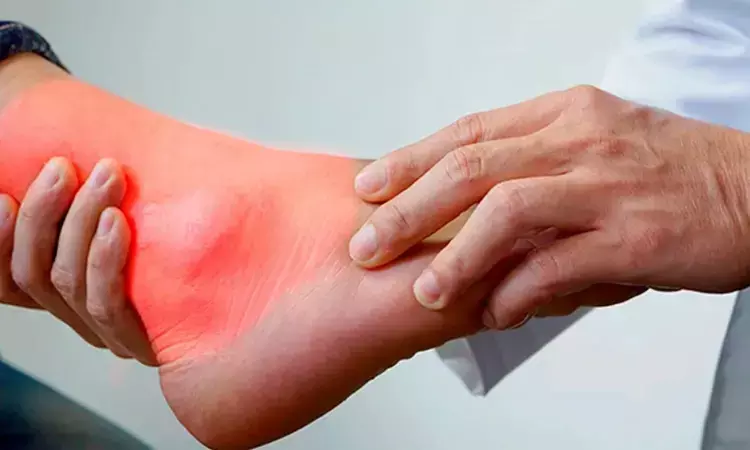- Home
- Medical news & Guidelines
- Anesthesiology
- Cardiology and CTVS
- Critical Care
- Dentistry
- Dermatology
- Diabetes and Endocrinology
- ENT
- Gastroenterology
- Medicine
- Nephrology
- Neurology
- Obstretics-Gynaecology
- Oncology
- Ophthalmology
- Orthopaedics
- Pediatrics-Neonatology
- Psychiatry
- Pulmonology
- Radiology
- Surgery
- Urology
- Laboratory Medicine
- Diet
- Nursing
- Paramedical
- Physiotherapy
- Health news
- Fact Check
- Bone Health Fact Check
- Brain Health Fact Check
- Cancer Related Fact Check
- Child Care Fact Check
- Dental and oral health fact check
- Diabetes and metabolic health fact check
- Diet and Nutrition Fact Check
- Eye and ENT Care Fact Check
- Fitness fact check
- Gut health fact check
- Heart health fact check
- Kidney health fact check
- Medical education fact check
- Men's health fact check
- Respiratory fact check
- Skin and hair care fact check
- Vaccine and Immunization fact check
- Women's health fact check
- AYUSH
- State News
- Andaman and Nicobar Islands
- Andhra Pradesh
- Arunachal Pradesh
- Assam
- Bihar
- Chandigarh
- Chattisgarh
- Dadra and Nagar Haveli
- Daman and Diu
- Delhi
- Goa
- Gujarat
- Haryana
- Himachal Pradesh
- Jammu & Kashmir
- Jharkhand
- Karnataka
- Kerala
- Ladakh
- Lakshadweep
- Madhya Pradesh
- Maharashtra
- Manipur
- Meghalaya
- Mizoram
- Nagaland
- Odisha
- Puducherry
- Punjab
- Rajasthan
- Sikkim
- Tamil Nadu
- Telangana
- Tripura
- Uttar Pradesh
- Uttrakhand
- West Bengal
- Medical Education
- Industry
DECT Leads to Faster Tophus Resolution Than Ultrasound in Gout Study

A new study published in the journal of Joint Bone Spine showed that dual-energy computed tomography (DECT) results in quicker complete tophus resolution compared to ultrasound in patients with gout.
Gout is the most prevalent cause of inflammatory arthritis globally and is brought on by the accumulation of monosodium urate (MSU) crystals following prolonged hyperuricemia. The inflammatory reaction to these MSU crystal deposits results in tophus development, gout flares, persistent arthritis, and ultimately erosive gout. The goal of managing gout is to use urate-lowering treatment (ULT) to completely dissolve MSU crystals, enabling flare-free gout remission.
Since ultrasound (US) may identify MSU deposits on the surface and tophi of cartilage, rheumatologists are increasingly using it as an addition to their clinical assessment. Dual-energy computed tomography offers direct assessment of substantial MSU crystal deposits and is a helpful technique for differentiating between urate, bone, and soft tissue. The study's primary goal was to assess the tophus volume dynamics in gout patients receiving treat-to-target (T2T) urate-lowering medication throughout the first 24 months of treatment using dual-energy CT and ultrasound.
The patients with gout and US tophi who had never used ULT were included in this multicenter, prospective, 24-month longitudinal pilot research. At baseline, 6, 12, and 24 months, clinical visits were conducted, along with DECT and US scans of the knees and foot. The index tophus was determined to be the largest tophus recognized by the United States. The Spearman correlation coefficient (ρ) was used to evaluate the correlation between the tophus index volume measured with US and with DECT at all timepoints, as well as the change in absolute volume and relative change from baseline.
The study comprised 55 patients, most of whom were male, aged 63.1 (12.3), and whose baseline blood urate levels were 8.73 mg/dL [7.93; 9.52]. From 0.1 cm3 [0; 0.63] at baseline to 0 cm3 [0; 0] at month 24, the index tophus volume assessed with US changed from the median [inter-quartile range] 0.61 cm3 [0.30; 1.20] at baseline to 0.07 cm3 [0; 0.50] at month 24.
The index tophus volume changed by −56% [−90; 0] and −96% [−100; −34] at M6, −84% [−100; −13] and −100% [−100; −89] at M12, and −96% [−100; −72] and −100% [−100; −100] at M24 for the same measurements. Relative tophus volume change showed a slight association at month 6 and a strong correlation at months 12 and 24. Overall, there is more variation in volumetric measurements during follow-up since complete tophus resolution is achieved at 24 months of T2T in DECT but not in the US.
Reference:
Pascart, T., Richette, P., Bousson, V., Ottaviani, S., Ea, H.-K., Lioté, F., Latourte, A., Bardin, T., Ora, J., Pacaud, A., Vandecandelaere, M., Luraschi, H., Jauffret, C., Laurent, V., Boissel, M., Norberciak, L., Legrand, J., Lefevre, G., Ducoulombier, V., & Budzik, J.-F. (2025). Time-course of tophus resolution on Dual-energy CT and ultrasound after 24 months of a treat-to-target strategy: Results from GOUT-DECTUS study. Joint, Bone, Spine: Revue Du Rhumatisme, 92(4), 105892. https://doi.org/10.1016/j.jbspin.2025.105892
Neuroscience Masters graduate
Jacinthlyn Sylvia, a Neuroscience Master's graduate from Chennai has worked extensively in deciphering the neurobiology of cognition and motor control in aging. She also has spread-out exposure to Neurosurgery from her Bachelor’s. She is currently involved in active Neuro-Oncology research. She is an upcoming neuroscientist with a fiery passion for writing. Her news cover at Medical Dialogues feature recent discoveries and updates from the healthcare and biomedical research fields. She can be reached at editorial@medicaldialogues.in
Dr Kamal Kant Kohli-MBBS, DTCD- a chest specialist with more than 30 years of practice and a flair for writing clinical articles, Dr Kamal Kant Kohli joined Medical Dialogues as a Chief Editor of Medical News. Besides writing articles, as an editor, he proofreads and verifies all the medical content published on Medical Dialogues including those coming from journals, studies,medical conferences,guidelines etc. Email: drkohli@medicaldialogues.in. Contact no. 011-43720751


